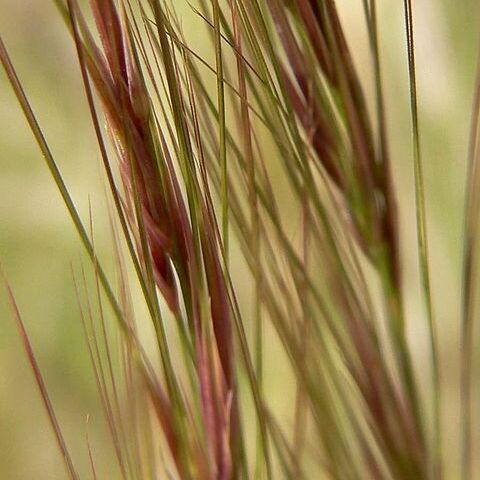Spikelets 1-fld, articulated above the glumes; glumes membranous, linear to lanceolate, 1(2–5)-nerved, acute, acuminate, or short-awned, the first sometimes deciduous; lemma indurate, linear, obscurely veined, closely convolute about the palea and grain, often scabrous on the obscure keel or toward the tapering summit, and with a sharp, usually bearded callus; awns of the lemma normally 3, elongate, similar or dissimilar; annual or perennial, often weedy, often branched from some or all the nodes, with narrow, often involute lvs, minute ligule, and terminal, usually slender or spike-like, dense or lax panicles or racemes. The awns, erect and parallel when immature or moist, diverge when dry and mature into characteristic positions. Lengths of the glumes and lemmas are here measured from the base of the spikelet. 200, mainly warm reg.
Densely tufted perennials or annuals, usually without a rootstock. Leaf-blades linear, usually in a basal tuft, but in annual species borne mainly on the culms. Panicle effuse, contracted, or spike-like. Spikelets 1-flowered with long scarious glumes; lemma cylindrical or laterally compressed, indurated, glabrous or scabrid, rarely sparsely hairy, the margins convolute or involute, produced into a 3-branched awn (rarely the lateral branches obsolete); awn with or without a column, articulated or not, the branches glabrous or scabrid, never plumose; callus well-developed, obtuse, bifid or acuminate; palea usually less than half as long as the lemma.
Perennials, less often annuals or suffruticose. Culms tufted. Leaf blades usually basal, rolled or rarely flat. Inflorescence a narrow or open panicle. Spikelets with 1 floret; glumes scarious, narrow, unequal with the upper usually longer, 1(–3)-veined; floret callus bearded, obtuse to pungent or 2-toothed; lemma narrowly cylindrical or laterally compressed, convolute, glabrous or sparsely hairy; awn 3-branched, branches arising directly from lemma apex or seated on a straight or twisted column, persistent or disarticulating either at base or apex of column (always persistent in China), scabrid. Stamens 3.
Spikelets 1-flowered, disarticulating above the glumes; glumes usually unequal, 1-nerved, or rarely 3-to 5-nerved, acuminate or awned; lemma indurate at matur-ity, terete, convolute around the palea, glabrous or scabrous toward the tip with a sharp, entire or minutely bifid, bearded callus; awns 3, the lateral sometimes very short or wanting, sometimes united at the base in a slender twisted column. Densely tufted annuals or perennials with involute or narrow flat blades *and open or contracted, occasionally spike-like panicles.
Lemma narrow, terete or laterally compressed, tapering upwards, with convolute or involute margins, 3-nerved, becoming indurated at maturity, bearing at the base an acute, or obtuse, or truncate, or 2-fid, or emarginate, hard, usually barbate callus, awned from the apex of the lemma or from the apex of a usually twisted column (prolongation of the lemma); articulation absent or present (at the apex of the lemma or at the apex of the column); awns 3(1 central, 2 lateral) or rarely 1, scabrous or glabrous.
Annual or perennial, mostly densely tufted, usually with erect or branched, usually solid, rigid culms and long, narrow leaf-laminae, having a ligule of a rim of cilia, and dense spiciform or effuse panicles.
Caryopsis terete or slightly compressed (rarely shallowly grooved), tightly enclosed by the lemma, usually free, with a linear hilum; embryo usually 1/3-1/2 the length of the caryopsis.
Glumes persistent, equal or unequal, narrow, usually 1-3(5) or 3-5-nerved, acute to acuminate or obtuse, or emarginate, mucronate or awn-tipped.
Spikelets 1-flowered, narrow, pedicelled, in terminal lax or contracted panicles.
Palea shorter than the lemma, not keeled, nerveless or 2-nerved, or absent.
Floret hermaphrodite, equalling or shorter than, or exceeding the glumes.
Rhachilla disarticulating obliquely above the glumes.
Ovary glabrous; styles free; stigmas 2, plumose.
Lodicules usually 2, rarely 3, obtuse or absent.
Stamens 1 or 3.

